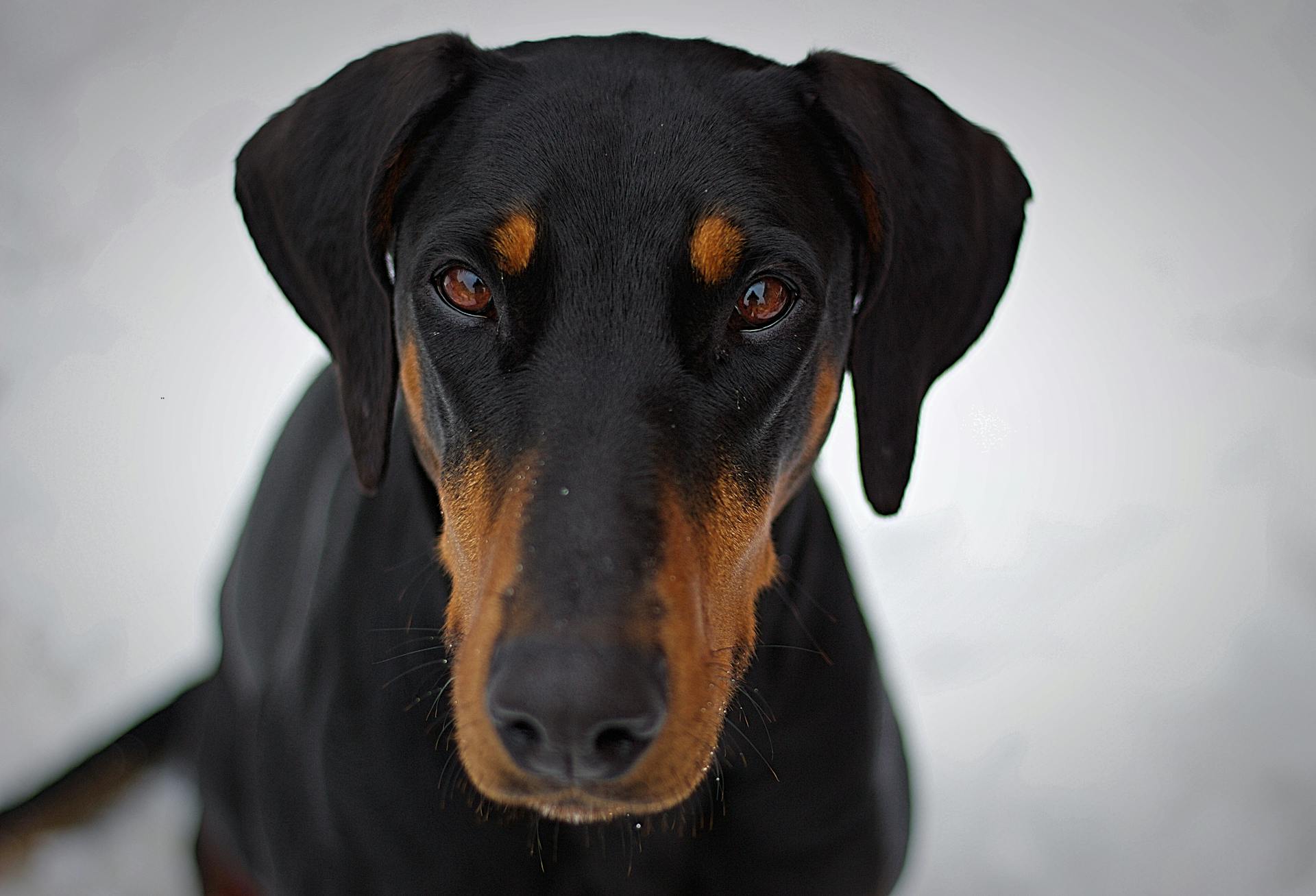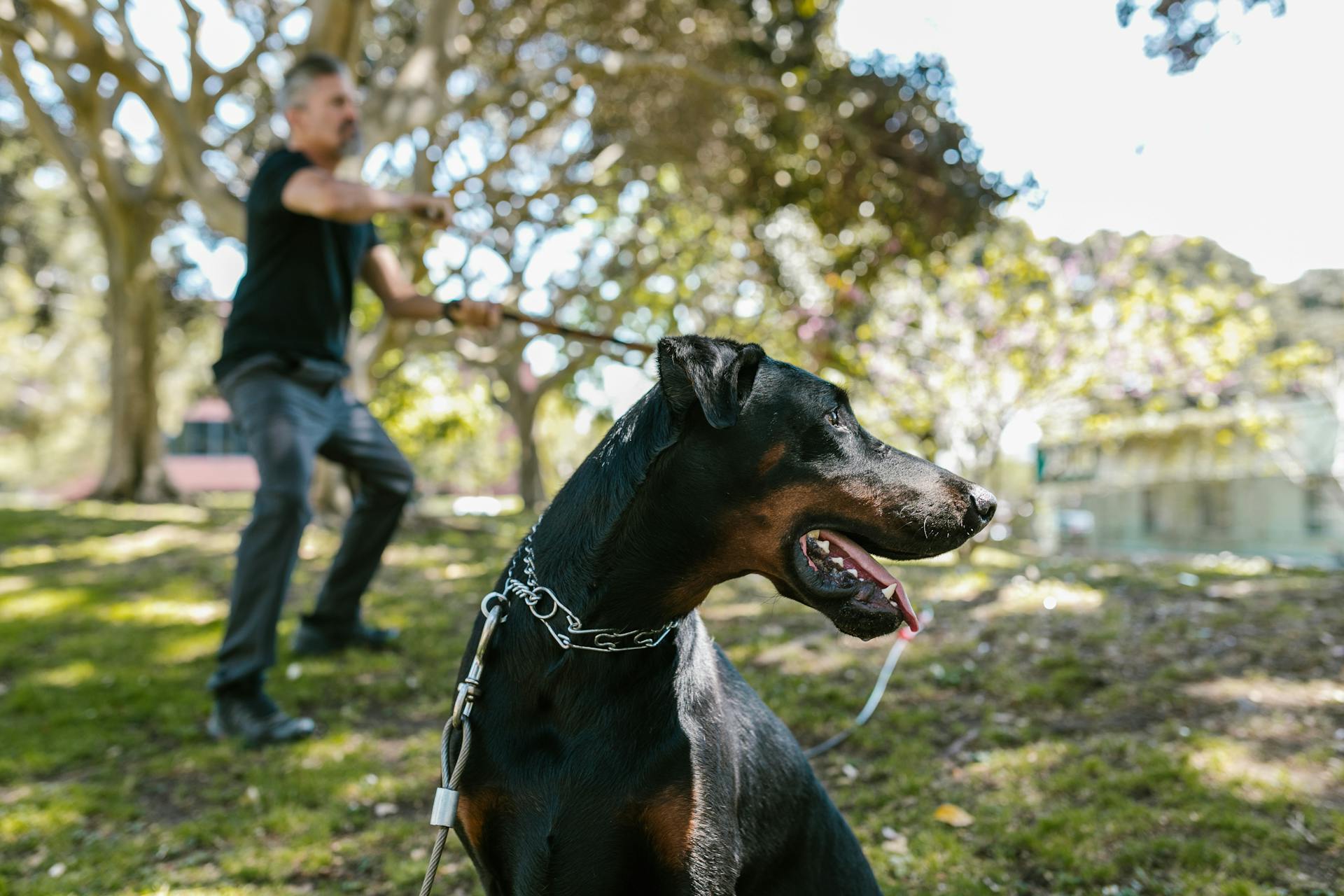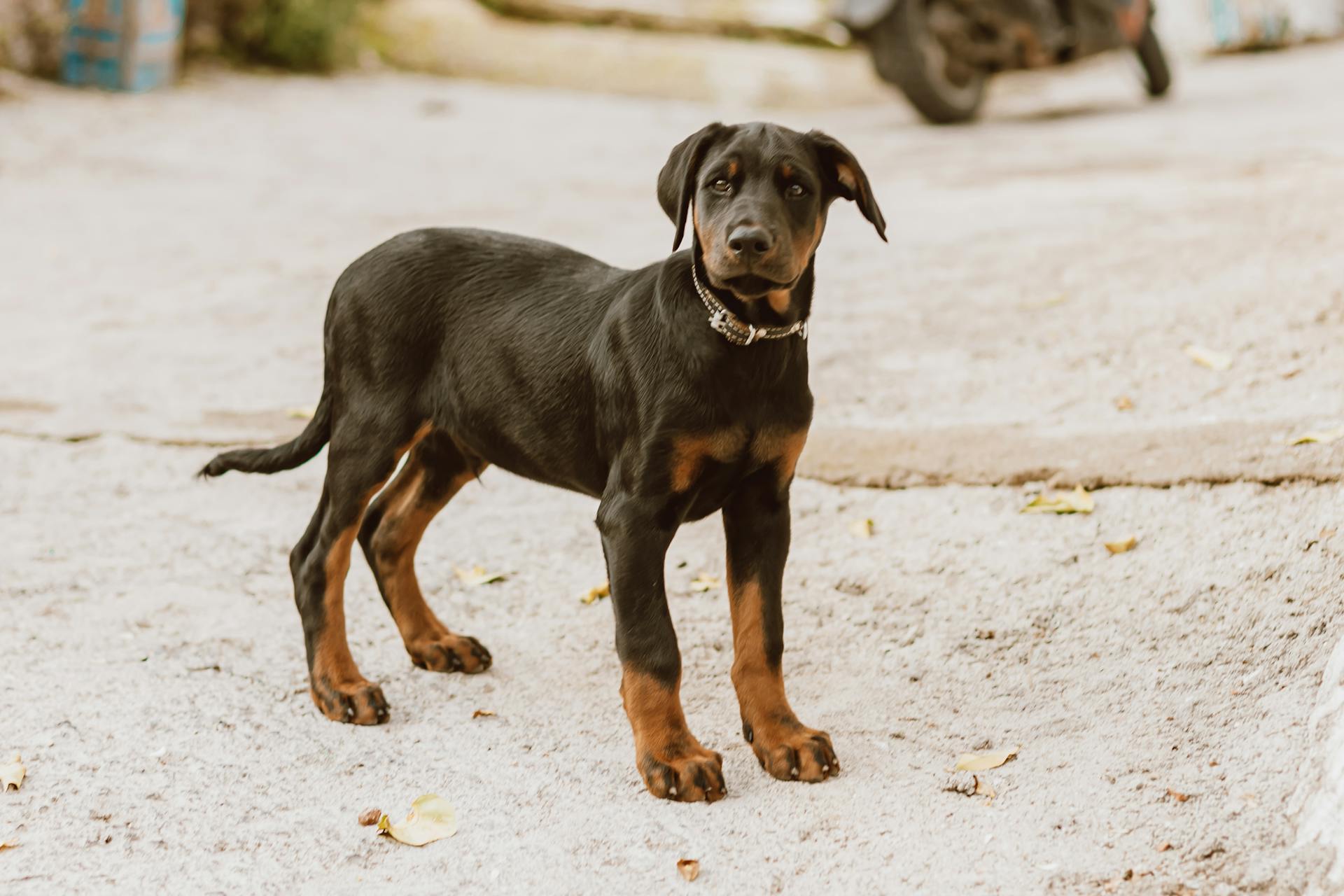
Doberman Pinschers are often misunderstood, but they're actually quite fascinating dogs. They originated in Germany in the late 19th century as a guard dog.
One of the most interesting facts about Doberman Pinschers is that they were bred to be intelligent and athletic. They were originally bred to be a combination of a Rottweiler, a Weimaraner, and a German Pinscher.
Their short, smooth coats require minimal grooming.
Care and Upkeep
Doberman Pinschers require daily mental and physical exercise, such as a long jog or vigorous play for at least an hour per day, to keep them happy and healthy.
They prefer temperate weather and enjoy retrieving, swimming, tugging, and running, but owners should have a well-fenced yard due to their capable jumping ability.
A weekly or twice-a-week brushing combined with occasional bathing is necessary for their coat care, and owners should be aware of the potential risks associated with tail docking and ear cropping.
Dobermans are prone to dilated cardiomyopathy, a breed-specific heart condition, and owners should consider getting a DNA test to identify the gene associated with the condition.
Regular cardiac evaluation, including an electrocardiogram and a baseline Holter heart monitor test, is recommended for dogs between one and two years of age.
Their high energy level means they may not be the ideal pet for families with very young children, and owners should train and socialize their Doberman puppy early and consistently to prevent destructive behaviors.
Doberman Pinschers have a strong prey drive, so they may not be suitable for homes with small animals unless there has been extensive socialization and training.
A different take: Doberman Pinscher Not Cropped
Nutritional Tips
Feeding your Doberman Pinscher a complete and balanced diet is crucial for their overall health. This can be achieved by feeding commercial kibble or wet food approved by the Association of American Feed Control Officials (AAFCO).
To support healthy muscles, including the heart, your Doberman needs easily digestible protein. Omega-3 fatty acids (DHA/EPA) also play a vital role in supporting healthy skin, coat, kidneys, and heart.
Feeding your Doberman two meals per day instead of one larger meal can help reduce the risk of GDV or bloat. This is especially important for Doberman puppies, who need to eat more frequently, at least three meals every day.
You should also avoid exercising your pup directly before or after eating, as this can increase the risk of GDV or bloat. Elevated food bowls can also contribute to this risk, so it's best to stick with a regular bowl.
The recommended caloric intake for Doberman Pinschers varies greatly, depending on their size, metabolism, and activity level. This is why it's essential to consult with your veterinarian to determine the best diet for your Doberman.
Adding omega-3 fatty acids (DHA/EPA) to your Doberman's diet can provide numerous health benefits, including acting as natural anti-inflammatories and supporting the skin, coat, kidneys, joints, and heart. Your veterinarian can help you determine the best way to incorporate these essential fatty acids into your Doberman's diet.
Explore further: Doberman Pinscher Diet
Care

Doberman Pinschers are high-energy dogs that require daily mental and physical exercise, such as a long jog or vigorous play for at least an hour per day.
Their short coats are relatively low-maintenance, but they still need weekly or twice-a-week brushing combined with occasional bathing.
To prevent boredom and destructive behavior, Dobermans need a stimulating lifestyle that includes daily walks or runs, weekend hikes, or regular playtime in the yard.
Their high energy level makes them unsuitable for families with very young children, as they can accidentally knock them down and be startled by loud noises.
Doberman Pinschers are intelligent and quick to learn tricks and commands, but they require consistent training from an early age.
A DNA test for dilated cardiomyopathy (DCM) is available, but it can have false positives and negatives, so regular cardiac evaluations are crucial.
Regular veterinary check-ups, including at least one annual physical exam, are essential to monitor their health and detect potential issues early on.
Dobermans are prone to hip dysplasia, Wobbler syndrome, and von Willebrand disease, so it's essential to feed them a diet that slows their growth rate and monitor their health closely.
With proper care and attention, Doberman Pinschers can thrive and become loyal and loving companions for their families.
Temperament and Personality
Doberman Pinschers are highly intelligent dogs that thrive on mental and physical stimulation. They require a patient owner who will dedicate themselves to their learning.
Doberman Pinschers are naturally protective of their family, which can make them great watchdogs. However, this also means they can develop separation anxiety if left alone for too long.
These dogs are energetic and need plenty of exercise and space for free play. If left without a way to entertain themselves, they can become destructive.
Doberman Pinschers are known as "Velcro dogs" because of their deep bond with their family. They love to stick by your side and can become anxious if separated from you for too long.
To prevent separation anxiety, it's essential to start training and socializing your Doberman from an early age. Kennel training can also be beneficial, but it's crucial to make the kennel a safe and comfortable space for your dog.
Suggestion: Is a Doberman Pinscher a Good Family Dog
Doberman Pinschers are generally not an aggressive breed, but they can be protective of their family and territory. With proper socialization and training, they can get along well with other dogs and people.
Despite their reputation as guard dogs, Doberman Pinschers can be fun and loving family dogs, especially with early socialization. They are usually patient with young children, but it's still essential to supervise interactions between kids and dogs.
Doberman Pinschers have a strong prey drive, which means they might chase small animals, including cats. However, with proper introduction and training, Doberman Pinschers and cats can live together harmoniously.
Related reading: Dog Training Facts
Health and Wellness
Doberman Pinschers are generally a healthy breed, but like all breeds, they can be prone to certain health issues. The average Doberman lifespan is 10 to 12 years.
Hip dysplasia is a common issue in Dobermans, and their heart and thyroids should be checked regularly. Bloat is another serious concern, with a 50% mortality rate.
Doberman Pinschers are also predisposed to cardiomyopathy, which is a common cause of death in the breed. In fact, 15% of Doberman deaths are cardiac-related, and the breed is particularly susceptible to dilated cardiomyopathy (DCM).
The following health issues are commonly seen in Doberman Pinschers:
- Cardiomyopathy
- Bloat
- Von Willebrand's Disease
- Wobbler's Syndrome
Other health concerns include von Willebrand's disease, prostatic disease, and hypothyroidism. The breed is also prone to gastric dilatation volvulus, with a 6.1% prevalence in one American study.
Doberman Health
The Doberman breed is generally considered healthy, but like all breeds, they can be prone to certain health issues. The average Doberman lifespan is 10 to 12 years.
One of the most common health issues Dobermans face is hip dysplasia, but it's less prevalent in this breed compared to others. A study found that only 1.34% of Dobermans have hip dysplasia.
Doberman Pinschers are also at risk for cardiomyopathy, a serious heart condition that can be fatal. In fact, a UK survey found that 15% of Doberman deaths are due to cardiac issues.
Discover more: Cons of Boxer Dogs
Bloat is another potential health concern for Dobermans, with a 50% mortality rate if left untreated. It's essential for owners to educate themselves on the symptoms of bloat and talk to their veterinarian about prevention methods.
Regular health checks are crucial to identify any potential issues early on. This includes checking the heart and thyroid regularly, as well as monitoring for signs of bloat.
Here are some common health issues Dobermans may face:
- Cardiomyopathy
- Bloat
- Von Willebrand's Disease
- Wobbler's Syndrome
It's also essential to have your Doberman's DNA tested for Von Willebrand's Disease, as this can help identify potential health risks. Additionally, regular X-rays and MRI scans can help detect any skeletal issues, such as hip dysplasia or intervertebral disc disease.
Life Expectancy
Life expectancy can be a concern for Dobermann owners, and the facts are a bit sobering. A 2024 UK study found a life expectancy of 11.2 years for the breed.
Unfortunately, this is lower than the average life expectancy for purebreeds, which is 12.7 years. In contrast, crossbreeds have an average life expectancy of 12 years.

A 2024 Italian study found a life expectancy of just 8 years for the breed. This is a significant difference from the overall life expectancy of 10 years.
Not all Dobermanns will reach old age, however. A 2005 Swedish study found that 68% of Dobermanns died by the age of 10, which is higher than the overall rate of 35% of dogs dying by the age of 10.
Breed Information
The Doberman Pinscher is a breed with a rich history and unique characteristics. The breed originated in Germany in the 1890s, developed by Karl Friedrich Louis Dobermann for his job as a dogcatcher and tax collector.
The Doberman Pinscher is a medium to large dog, standing between 24-28 inches tall and weighing between 60-100 pounds. They have a short, smooth coat that comes in four recognized colors: black, red, blue, and fawn.
Here are some key breed facts:
- Other name: Doberman, Dobie, Dobe
- Area of origin: Apolda, Germany
- Breed group: Working
- Life span: 10-12 years
The Doberman Pinscher is a loyal and intelligent breed that requires regular exercise and mental stimulation to prevent boredom and anxiety. With proper care and training, they can make wonderful companions.
Breed
The Doberman Pinscher breed has a rich history, originating in Germany in the 1890s. Karl Friedrich Louis Dobermann, a dogcatcher and tax collector, developed this breed as a personal protection dog.
This breed is known for being intelligent, loyal, and brave, with a naturally protective instinct and a reliable nature. They have a strong build and short, smooth, glossy fur that accentuates their athletic appearance.
The Doberman Pinscher is a medium to large dog, standing between 24-28 inches tall and weighing between 60-100 pounds. They have a wedge-shaped head, almond-shaped eyes, and powerful jaws.
Their iconic look features triangular ears that are carried erect and a stub of a tail, but these dogs are actually born with long tails that have a tendency to curl up. The cropped look is considered the breed standard for the American Kennel Club.
There are four recognized colors for Doberman Pinschers: black, red, blue, and fawn, all sporting distinctive rust-colored markings on their face, chest, and legs. In rare cases, however, one of these dogs may be born albino, a pale cream color referred to as white.
Related reading: How to Spell Shih Tzu Dog
Here's a summary of the breed facts:
The Doberman Pinscher is a clean animal with very low odor, making their grooming requirements minimal. Regular brushing and occasional wiping down with a wet cloth will help to reduce shedding and odor.
History
The Doberman Pinscher has a rich history that spans over a century. It all began in the 1880s with Louis Dobermann, a tax collector and breeder from Apolda, Germany, who wanted to create a breed that would serve as excellent watchdogs.
Dobermann's vision was to breed a dog that would exhibit impressive stamina, strength, and intelligence. He mixed different breeds together to achieve this goal, but the exact breeds used remain uncertain.
The old German shepherd and German pinscher are thought to have played a major role in the breed's development. These two dogs are also believed to be the ancestors of the Rottweiler and the Weimaraner.
After Dobermann's death in 1894, the breed was named Dobermann-pinscher in his honor. However, the Germans dropped the "pinscher" part in the 1940s, deeming it no longer representative of the breed.
Take a look at this: German Doberman Pinscher
The breed was recognized by the American Kennel Club in 1908 and has since become one of the most popular breeds in the U.S. Today, Dobermans are still valued for their intelligence and loyalty, but they are no longer as widely used as they once were in military and police roles.
Appearance
A Doberman pinscher's appearance is unmistakable, with a slender, athletic, and powerful build that's hard to miss.
They stand over 2 feet tall, with females typically reaching 26 inches and males around 28 inches in height.
Their coats come in four main colors: black, red, blue, or fawn, and are usually solid in color with some brown markings on their eyes, muzzle, feet, and legs.
Their eyes are dark and piercing, giving them a distinctive look.
At birth, Doberman pups have relaxed ears and tails that can grow up to 12 inches long, but many are docked and ears are cropped for cosmetic reasons.
Consider reading: Doberman Pinscher with Ears
Frequently Asked Questions
What 2 breeds make a Doberman?
The Doberman Pinscher is believed to be a cross between several breeds, including the German Pinscher and Rottweiler. However, the exact breeds and ratios used in its development are still uncertain.
What is unique about Dobermans?
Dobermans are known for their exceptional courage, intelligence, and loyalty, making them a popular breed for protection and companionship. Their origins in Germany and versatility in police and military work also set them apart.
What is a Doberman Pinscher weakness?
Doberman Pinschers are prone to a heart condition called dilated cardiomyopathy (DCM), which can lead to weakness, exhaustion, and frequent collapses. This inherited health issue affects the dog's heart's ability to pump blood effectively.
Featured Images: pexels.com

